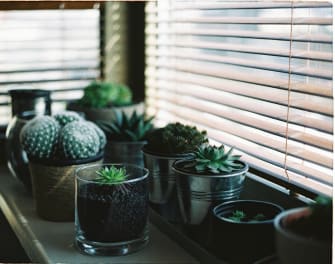When caring for indoor plants, a focus is often (rightfully!) on watering them appropriately. Too little and they can’t thrive. Water them too much and the oversaturated soil can cause root rot to occur.

Besides watering your plants the ideal amount and frequency, you’ll also need indoor plant pottery that allows the soil to appropriately drain—which is one of the best things you can do to grow and maintain healthy indoor plants.
What is Root Rot?
Plants have root systems that anchor them into the soil and allow them to absorb water from the surrounding area. Nature designed plant roots to continue to absorb available water. So, when more is available than what they need, the roots will still keep taking in that fluid.
In some situations, this will lead to root rot, a condition that can kill a plant. In fact, it can be challenging, although not impossible, for a plant to return to good health after root rot occurs.
Here’s what happens. Most commonly caused by overwatering—or a combination of overwatering and poor drainage—soil in a pot becomes quite wet. There may even be standing water in the soil. This creates an ideal environment for bacteria and fungi to grow, which in turn suffocates plant roots. Or, root rot can occur when a plant is in too wet of conditions for a period of time. With overwatering, plant roots won’t get enough oxygen. This prevents the plant from properly photosynthesizing and, because the plant can’t get enough nutrition, it dies.
Signs of root rot include yellow or black leaves; shriveled leaves; fungus gnats around the plant; and a sour smell. With appropriate transplanting after root care is performed, some plants survive root rot, but many do not. That’s why the best cure is prevention—which includes using indoor plant pots with drainage holes.
Choosing Indoor Plant Pottery
For in-depth advice, check out our post on selecting indoor pottery. In this article, we’ll focus on picking the right pots for optimal drainage and plant health. Many earthenware containers make it easy, coming with drainage holes in the bottom. If you’re going to move this pottery around—perhaps taking it outside during a beautiful summer day—you’ll probably notice soil falling out of the drainage hole. You can place one rock that largely fits the hole but still allows water to seep out to prevent soil from falling out.
Or, you can use a cache pot in a double potting system. You’d place your plant into a clay or plastic pot that has an appropriate drainage hole and then place that pot into a decorative one that looks attractive and fits your décor. Any excess water would drain from the indoor plant pots with drainage holes into the decorative pottery, removing the extra water from the reach of the plants’ roots. Using this double-pot system is sometimes called “staging.”
Watering with Indoor Pottery
Even with indoor pots with drainage holes, it’s important to know how much to water your plants for optimal health. This can vary based on the type of plant. In general, though, soil should be moist without becoming wet. Dried out soil typically means that there isn’t enough moisture for the plant’s roots to absorb.
For many plants, you’ll water once or twice a week during the spring and summer and less often during the other two seasons. A handful of aquatic plants exist that appreciate more water, but most need drainage as described in this post.
If you have questions about how often to water your indoor plants—or about choosing the proper soil—just let us know. You can contact our experts online or stop by our retail garden center or call us at (631) 201-1148 during business hours. To make everything super easy, we offer self-watering pots in three different sizes.
Indoor Pottery Materials
In general, plastic or ceramic pots are best for your indoor plants. Lightweight plastic pots are affordable, durable, and easy to clean and plastic won’t absorb water (like clay does). So, you won’t have to water plants in plastic indoor pottery as often. Because they come in a rainbow of sizes and colors, you can find what you’re looking for at Decker’s Nursery. If there is another kind of pottery that appeals to you, you can go with the cache pot approach described earlier.
Right-Size Your Indoor Pots
You can also ask our expert team about what size makes sense for the plants you want to grow. The answer will depend upon the anticipated diameter of each plant’s root system and how quickly the plant is likely to grow. When a pot is too small, soil dries out too quickly—which makes it clear why the size of indoor plant pottery plays a direct role in how much you water the houseplants.
When indoor plant pottery is too large, the soil may take on more water (and we know how plant roots will respond!). Plus, when a pot contains more water than it should, it doesn’t dry out quickly enough, which can trigger the growth of mold. Finally, some plants do especially well when root bound, and that won’t happen in a too-large pot.
Indoor Pottery at Decker’s Nursery
When you want to buy indoor pottery for your houseplants, talk to the experts here at Decker’s Nursery. Our retail garden center overflows with an enormous range of pottery from all around the world in a broad range of shapes, sizes, and colors. Plus, our expert team can help you find what you want and answer all of your questions.
So, stop by our garden center and nursery any time during our business hours. Or contact us online or call (631) 201-1148. We’re here to help you grow beautiful indoor plants in pots that look attractive and drain well for the good health of your houseplants.
